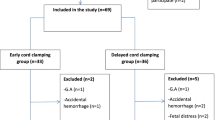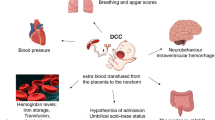Abstract
Purpose
This study aimed to compare the effects of early cord clamping (ECC), delayed cord clamping (DCC), and umbilical cord milking (MC) on maternal and neonatal outcomes in elective cesarean births.
Methods
We analyzed 204 women with uncomplicated at-term singleton pregnancies, who underwent cesarean birth under regional anesthesia between March and July 2021. The women were randomized into three groups: DCC (clamped 60 s postpartum), ECC (clamped within 15 s postpartum), or MC (clamped after milking five times) group. The neonatal and maternal outcomes of the groups were evaluated.
Results
The duration of the operation was significantly lower (P < 0.001) in the MC group at 50 min (ECC, 60 min; DCC, 60 min), while intraoperative bleeding was significantly higher (P < 0.001) in the ECC group at 500 mL (DCC, 300 mL; MC, 225 mL). The rates of anemia and polycythemia significantly differed (P = 0.049) between the three groups. DCC and MC did not negatively affect maternal and neonatal outcomes compared with ECC.
Conclusion
DCC and MC are superior to ECC in terms of short-term maternal and neonatal outcomes in cases of elective cesarean birth under regional anesthesia.

Similar content being viewed by others
Data availability
The datasets generated and/or analyzed during the current study are available from the corresponding author on reasonable request until 5 years after publication.
References
Delbaere I, Cammu H, Martens E, Tency I, Martens G, Temmerman M (2012) Limiting the cesarean section rate in low risk pregnancies is key to lowering the trend of increased abdominal deliveries: an observational study. BMC Pregnancy Childbirth 12:3. https://doi.org/10.1186/1471-2393-12-3
Andersson O, Lindquist B, Lindgren M, Stjernqvist K, Domellöf M, Hellström-Westas L (2015) Effect of delayed cord clamping on neurodevelopment at 4 years of age: a randomized clinical trial. JAMA Pediatr 169:631–638. https://doi.org/10.1001/jamapediatrics.2015.0358
Rana N, Kc A, Målqvist M, Subedi K, Andersson O (2019) Effect of delayed cord clamping of term babies on neurodevelopment at 12 months: a randomized controlled trial. Neonatology 115:36–42. https://doi.org/10.1159/000491994
Katheria A, Garey D, Truong G et al (2018) A randomized clinical trial of umbilical cord milking vs delayed cord clamping in preterm infants: neurodevelopmental outcomes at 22–26 months of corrected age. J Pediatr 194:76–80. https://doi.org/10.1016/j.jpeds.2017.10.037
American College of Obstetricians and Gynecologists (2010) Interim update. ACOG Comm Opin 131:194–199
Mercer JS, Erickson-Owens DA (2012) Rethinking placental transfusion and cord clamping issues. J Perinat Neonatal Nurs 26:202–217. https://doi.org/10.1097/JPN.0b013e31825d2d9a
Purisch SE, Ananth CV, Arditi B et al (2019) Effect of delayed vs immediate umbilical cord clamping on maternal blood loss in term cesarean delivery: a randomized clinical trial. JAMA 322:1869–1876. https://doi.org/10.1001/jama.2019.15995
Solanki M, Dewangan M, Anjum S, Ali SM (2017) Effect of timing of umbilical cord clamping on hemoglobin and hematocrit levels in preterm deliveries. Int J Med Paediatr Oncol 3:115–118
Erickson-Owens DA, Mercer JS, Oh W (2012) Umbilical cord milking in term infants delivered by cesarean section: a randomized controlled trial. J Perinatol 32:580–584. https://doi.org/10.1038/jp.2011.159
Zhou YB, Li HT, Zhu LP, Liu JM (2014) Impact of cesarean section on placental transfusion and iron-related hematological indices in term neonates: a systematic review and meta-analysis. Placenta 35:1–8. https://doi.org/10.1016/j.placenta.2013.10.011
Tran CL, Parucha JM, Jegatheesan P, Lee HC (2020) Delayed cord clamping and umbilical cord milking among infants in California neonatal intensive care units. Am J Perinatol 37:151–157. https://doi.org/10.1055/s-0039-1683876
Cavallin F, Galeazzo B, Loretelli V et al (2019) Delayed cord clamping versus early cord clamping in elective cesarean section: a randomized controlled trial. Neonatology 116:252–259. https://doi.org/10.1159/000500325
Oddie S, Rhodes P, Very Preterm Birth Qualitative Collaborative Group (2014) Barriers to deferred cord clamping in preterm infants. Arch Dis Child Fetal Neonatal Ed 99:F391–F394. https://doi.org/10.1136/archdischild-2014-305968
McDonald SJ, Middleton P, Dowswell T, Morris PS (2014) Cochrane in context: effect of timing of umbilical cord clamping in term infants on maternal and neonatal outcomes. Evid Based Child Health 9:398–400. https://doi.org/10.1002/ebch.1965
Songthamwat M, Witsawapaisan P, Tanthawat S, Songthamwat S (2020) Effect of delayed cord clamping at 30 seconds and 1 minute on neonatal hematocrit in term cesarean delivery: a randomized trial. Int J Womens Health 12:481–486. https://doi.org/10.2147/IJWH.S248709
Qian Y, Ying X, Wang P, Lu Z, Hua Y (2019) Early versus delayed umbilical cord clamping on maternal and neonatal outcomes. Arch Gynecol Obstet 300:531–543. https://doi.org/10.1007/s00404-019-05215-8
Rosenkrantz TS, Oh W (2010) Polycythemia and Hyperviscosity in the Newborn, 2nd edn. Cambridge University Press, United Kingdom, pp 127–140
Janus J, Moerschel SK (2010) Evaluation of anemia in children. Am Fam Physician 81(12):1462–1471
Faul F, Erdfelder E, Lang AG, Buchner A (2007) G*Power 3: a flexible statistical power analysis program for the social, behavioral, and biomedical sciences. Behav Res Methods 39:175–191. https://doi.org/10.3758/bf03193146
Chantry CJ, Blanton A, Taché V, Finta L, Tancredi D (2018) Delayed cord clamping during elective cesarean deliveries: results of a pilot safety trial. Matern Health Neonatol Perinatol 4:16. https://doi.org/10.1186/s40748-018-0083-3
Hutton EK, Hassan ES (2007) Late vs early clamping of the umbilical cord in full-term neonates: systematic review and meta-analysis of controlled trials. JAMA 297:1241–1252. https://doi.org/10.1001/jama.297.11.1241
Yao AC, Moinian M, Lind J (1969) Distribution of blood between infant and placenta after birth. Lancet 2:871–873. https://doi.org/10.1016/s0140-6736(69)92328-9
Katheria A, Reister F, Essers J et al (2019) Association of umbilical cord milking vs delayed umbilical cord clamping with death or severe intraventricular hemorrhage among preterm infants. JAMA 322:1877–1886. https://doi.org/10.1001/jama.2019.16004
Chiruvolu A, Medders A, Daoud Y (2021) Effects of umbilical cord milking on term infants delivered by cesarean section. Am J Perinatol 38:1042–1047. https://doi.org/10.1055/s-0040-1701617
Acknowledgements
We thank the nursing and laboratory staff of Acıbadem Maslak Hospital, with special thanks to Marina Akman, Mehri Bazarova, and Merve Demir. We would also like to thank Editage (www.editage.com) for English language editing.
Funding
This research did not receive any specific grant from funding agencies in the public, commercial, or not-for-profit sectors.
Author information
Authors and Affiliations
Corresponding author
Ethics declarations
Conflict of interest
The authors have no relevant financial or non-financial interests to disclose.
Ethical approval
This prospective, randomized study was conducted in a single institution from March to July 2021. The study protocol was approved by the Ministry of Health, Turkish Medicines and Medical Devices Agency (E-66175679–514.11.01–350571) and Medical Ethics Committee of the Institutional Ethical Review Board of Acıbadem Mehmet Ali Aydınlar University School of Medicine (ATADEK-2021–01/44). This study was registered at clinicaltrials.gov (NCT04812223) (https://clinicaltrials.gov/ct2/show/NCT04812223).
Consent to participate
All participants who agreed to participate in this study provided written informed consent on the day of the surgery.
Additional information
Publisher's Note
Springer Nature remains neutral with regard to jurisdictional claims in published maps and institutional affiliations.
Rights and permissions
Springer Nature or its licensor (e.g. a society or other partner) holds exclusive rights to this article under a publishing agreement with the author(s) or other rightsholder(s); author self-archiving of the accepted manuscript version of this article is solely governed by the terms of such publishing agreement and applicable law.
About this article
Cite this article
Ozbasli, E., Takmaz, O., Unsal, G. et al. Effects of cord clamping timing in at-term elective cesarean section on maternal and neonatal outcomes: a randomized trial. Arch Gynecol Obstet 309, 1883–1891 (2024). https://doi.org/10.1007/s00404-023-07054-0
Received:
Accepted:
Published:
Issue Date:
DOI: https://doi.org/10.1007/s00404-023-07054-0




